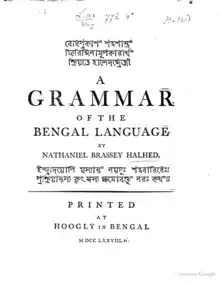Panchanan Karmakar
Panchanan Karmakar (Mallick) (died c. 1804) was an Indian Bengali inventor, born at Tribeni, Hooghly, Bengal Presidency, British India,[1] hailed from Serampore. He assisted Charles Wilkins in creating the first the Bangla type.[2] His wooden Bengali alphabet and typeface had been used until Ishwar Chandra Vidyasagar proposed a simplified version.[3] Apart from Bangla, Karmakar developed type in 14 languages, including Arabic, Persian, Marathi, Telugu, Burmese and Chinese.[2]
Panchanan Karmakar | |
|---|---|
পঞ্চানন কর্মকার | |
| Born | |
| Died | 1804 |
Early life and career

Karmakar was born in Tribeni.[4] His ancestors were calligraphers; they inscribed names and decorations on copper plates, weapons, metal pots, etc.[2]
Andrews, a Christian missionary, had a printing press at Hughli. In order to print Nathaniel Brassey Halhed's A Grammar of the Bengal Language, he needed a Bangla type.[2] Under the supervision of English typographer Charles Wilkins, Karmakar[5] created the first Bengali typeface for printing.[6]
In 1779, Karmakar moved to Kolkata to work for Wilkins' new printing press.[2] in Chinsurah, Hooghly. In 1801, he developed a typeface for British missionary William Carey's Bangla translation of the New Testament.[7] In 1803, Karmakar developed a set of Devnagari script, the first Nagari type to be developed in India.[2]
References
- "Panchanan Karmakar - Banglapedia". en.banglapedia.org. Retrieved 2021-07-04.
- Islam, Sirajul (2012). "Panchanan Karmakar". In Islam, Sirajul; Hossain, Ayub (eds.). Banglapedia: National Encyclopedia of Bangladesh (Second ed.). Asiatic Society of Bangladesh.
- Ghulam Morshed. "Vidyasagar, Pundit Iswar Chandra". Banglapedia. Retrieved March 20, 2016.
- "পঞ্চানন কর্মকার". onushilon.org. Retrieved 2021-07-04.
- Greenspan, Ezra; Rose, Jonathan (September 2003). Book History - Ezra Greenspan, Jonathan Rose. ISBN 0271023309. Retrieved 2015-06-02.
- Works [ed. by E.R. Rost]. - Horace Hayman Wilson -. 1865. p. 273. Retrieved 2015-06-02 – via Internet Archive.
charles wilkins.
- TNN (February 9, 2012). "Flower power resurrects Carey legacy". The Times of India. Retrieved March 20, 2016.